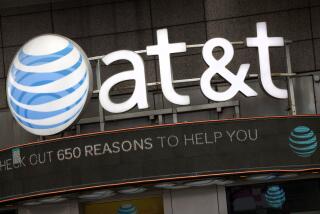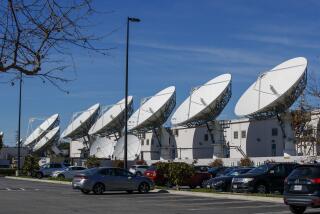Sun Microsystems Is Blazing a Red-Hot Trail in Computers : $300-Million AT&T; Deal Moves Firm to Set Sights on IBM
- Share via
The whiz kids at Sun Microsystems might seem a little smug these days. Along with a lot of other people, Sun’s youthful executives think they’ve pulled off the deal of a business lifetime, a pact with American Telephone & Telegraph that could assure the brash company a pivotal role in the treacherous computer industry.
“I’m just busting out all over. . . . Things couldn’t have worked out better,” boasted Scott McNealy, the Mountain View, Calif., company’s hard-driving, 33-year-old president and chief executive. “We are dealing now with insurmountable opportunity. If we screw it up, we will have only ourselves to blame.”
The deal with AT&T; that was announced Jan. 6, calling for the telecommunications giant to invest about $300 million in Sun, is the latest product of the computer company’s audacious, make-things-happen style. That style, which some outsiders find arrogant, has nonetheless served Sun well. In less than six years, it has grown from the classic Silicon Valley start-up firm to a nearly $1-billion-a-year company feared by competitors many times its age and size.
Since 1982, Sun has waged an aggressive assault on the computer market with its technical workstations. The machines, commonly used by engineers and scientists, look like personal computers but actually are far more powerful and costly, with price tags in the $5,000 to $100,000 range. Early last year, Sun became the top-selling workstation manufacturer in the United States, toppling archrival Apollo Computer as the industry’s leader; in 1987, Sun captured an estimated 23% to 25% of the $2.1-billion U.S. market.
Goal Possible, Analysts Say
Now McNealy and the rest of his management team are setting their sights even higher. The goal is to become a “broad-based, general purpose computing company” that can compete across the product spectrum with the likes of $8-billion-a-year Digital Equipment Corp. and even $54-billion-a-year IBM.
The plan doesn’t necessarily mean that Sun will make everything from mainframes to personal computers. Rather, McNealy said Sun eventually will produce machines powerful enough to replace today’s mainframes and small enough to fit easily on an office desk.
Analysts say the company’s goal isn’t so farfetched.
“They’ve got the strongest momentum of any (computer) company,” said Jonathan Fram, an analyst with the Bear, Stearns & Co. investment firm in New York. “Sun is a major, serious player.”
Some chafe at Sun’s aggressiveness and wonder if the company has gotten a little too cocky. “Brash and arrogant is what the critics call McNealy,” said one analyst. “But the management seems to have mellowed a bit now. They’ve learned to go at the world more gently, more subtly and with more sophistication.”
McNealy at times still shows why his staff calls him the “old Scot.” During a recent interview, he responded to a reporter’s query about the company’s goals with another question. “Why have goals?” he asked. “They only limit you.”
Sun’s success so far is testimony to its novel, “sell ‘em standards” business philosophy. The deceptively simple strategy, which flew in the face of conventional wisdom when the company started operations, allows Sun to offer its customers machines that can be tied into nearly any other computer system.
The connection is provided through the Unix operating system, a standard set of internal computer instructions developed by AT&T; in the 1960s. Unlike other operating systems, Unix can be adapted to run everything from the least powerful personal computer manufactured in South Korea to state-of-the-art supercomputers capable of guiding space warfare. AT&T; owns the operating system and licenses it to computer makers.
Sun’s founders turned to Unix because of their conviction that the computer industry needed an equivalent to the internal combustion engine. As Sun co-founder and software guru William Joy is fond of saying, the internal combustion engine is a sort of operating system that works equally well in a fancy Cadillac or a lowly Volkswagen Beetle.
“The strategy is elegant in its simplicity,” said Robert Herwick, a technology analyst with Hambrecht & Quist in San Francisco.
However simple, it was a radical departure when Sun started up.
At the time, the prevailing wisdom was that high-powered computers, such as those made by Sun and its rivals, should operate on their own, unique systems. This approach, it was thought, would prevent copycat competition and ensure fat profits to those companies executing it well, such as Digital Equipment, Apollo and IBM.
But the strategy had a glaring weakness: The proprietary systems are, for the most part, incompatible. Digital customers, for example, couldn’t add IBM personal computers to their networks; IBM mainframe users couldn’t even add less powerful IBM machines to their systems. So, unless customers scrapped their existing systems and started anew, their computing choices were limited largely to what they were already using.
By installing Unix as its operating system, Sun became one of the first computer makers to offer what its founders like to call “freedom of choice, not freedom from choice.”
And they discovered that customers liked it. Major accounts now include General Electric, Boeing, Lockheed and the National Security Agency.
Founders Shared Dream
“The company has done virtually everything right,” said Donald Sinsabaugh, analyst with Swergold, Chefitz & Sinsabaugh in New York. “The management has gone out and taken on the world.”
That’s just what Sun’s four founders--all 27 years old at the time--intended.
The four--McNealy, Joy, Andreas Bechtolsheim and Vinod Khosla--were brought together in 1982 by a shared dream. They wanted to build a computer designed for the engineers and office workers who actually use the machines--not the technicians or financiers who design or underwrite them.
The design came from Bechtolsheim, then a Stanford University electrical engineering graduate student who wanted to build a powerful computer that he and other students on campus could use in their studies.
Bechtolsheim assembled the first Sun computer--the name is an acronym for Stanford University Network--with parts readily available from nearby Silicon Valley electronics suppliers and then advertised locally for some backers.
Enter Khosla, a Stanford Business School graduate and Silicon Valley venture capitalist. Khosla, who has since left Sun, convinced Bechtolsheim that his product idea was too powerful to be limited to a university and deserved to be the centerpiece of a new company.
Khosla wrote a business plan for Sun that attracted some venture capital investments. To run the fledgling business, Khosla recruited McNealy, his business school roommate, who had been managing a small high-tech manufacturing outfit.
An Altruistic Goal
The key find, however, was Joy, a computer sciences graduate student at the University of California, Berkeley, who already had earned a reputation as a software genius for developing one of the most popular versions of Unix. Although Joy was being hotly recruited by other companies, he said he went over to Sun because of its commitment to Unix and its users.
“We want to make Unix more successful. It’s kind of an altruistic goal,” Joy explained. “Someday they’ll map a gene, and it probably will be done on Unix.”
Joy, regarded as the computer visionary guiding Sun’s product development, also is one of Sun’s chief merrymakers. And sometimes the pranks are on him. On one April Fool’s Day, company engineers disassembled Joy’s Ferrari and reassembled it on a platform in the middle of the company’s landscaped pond.
Although having fun is tolerated, Sun generally is an intense company populated by workaholics who routinely spend 75 hours or more each week on the job. Still, along with Apple Computer, Sun is considered one of the glamorous places to work in Silicon Valley.
“The decision-making process here is faster than at any place I’ve been, even Apple,” said Joseph Graziano, Sun’s new chief financial officer, who held the same position at Apple for several years.
Maintaining Sun’s growth rate, which has been running at more than 50% per year, won’t be easy, and Sun has turned to its historic strengths--AT&T; and Unix--for help.
“We decided we want to be a multibillion-dollar company,” said Edward J. Zander, marketing vice president. “We’ve taken a major step.”
The recently announced deal with AT&T; calls for the telecommunications company to invest roughly $300 million to acquire a 20% stake in Sun. The investment, which should be enough to finance Sun’s growth for the next several years, underscores an earlier agreement with AT&T; to jointly develop a new version of Unix that could dictate the direction of the technical and business computer market during the next two decades.
Rival Firms Upset
However, within days of learning of the AT&T; deal, more than a dozen of Sun’s competitors met to plot a strategy to loosen the ties between Sun and the telecommunications giant. The companies charge that the AT&T; deal gives Sun an unfair advantage. Some of the rivals are even suggesting that the pact raises important antitrust issues that might wind up in court.
“It’s no longer a level playing field,” complained Mark Hatch, a software product marketing manager from Apollo Computer who helped organize the group of manufacturers opposed to the pact. “We’re concerned about the competitive balance. . . . This tilts it toward Sun.”
Hatch said the other Unix licensees want to participate actively in the development of the new operating system to ensure that it will reflect the needs of all computer manufacturers using Unix, not just Sun.
Without the participation, said Lawrence Lytle, a technical systems analyst and spokesman for Hewlett-Packard, computer makers will find themselves marching to Sun’s beat.
“It’s unacceptable to be in the position that we have to adhere to and compete with a standard that your major competitor defines and controls,” Lytle said. “This is not a trivial matter.”
The arguments don’t impress Sun’s McNealy.
In fact, McNealy said he isn’t interested in including his competitors in his deal with AT&T; and wonders where these companies were in 1984 when Sun started collaborating with AT&T; on some minor Unix revisions.
“It didn’t bother anyone then,” McNealy said. “All of a sudden we’re not the cute, little company. Now we’re a big pain in the butt.”
SUN MICROSYSTEMS’ SALESBased on fiscal 1987 sales of $537.5 million
33%
Design automation and manufacturing
23%
Computer-aided software engineering
19%
* Emerging markets
* Including artificial intelligence, financial services, imaging, biotechnology)
12%
Scientific research
6%
Computer-aided publishing
7%
Other
Source: Robertson, Colman & Stephens






